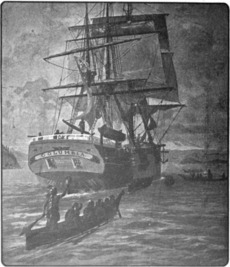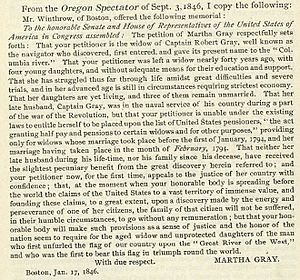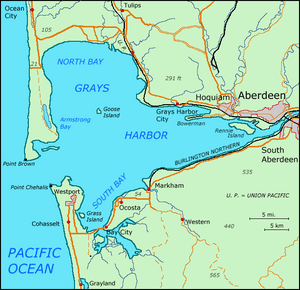Robert Gray (sea captain) facts for kids
Quick facts for kids
Captain Robert Gray
|
|
|---|---|
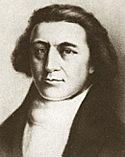
Captain Gray
|
|
| Born | May 10, 1755 |
| Died | July 1806 (aged 51) Atlantic Ocean
|
| Occupation | Merchant Sea-Captain, Explorer |
| Spouse(s) | Martha |
Robert Gray (born May 10, 1755 – died around July 1806) was an American sea captain and explorer. He is famous for his two trading trips to the northern Pacific coast of North America between 1790 and 1793. These trips helped start the American maritime fur trade in that area.
During his voyages, Gray explored parts of the coast. In 1790, he completed the first American trip around the world. He is also known for finding and naming the Columbia River in 1792, during his second trip.
Gray was born in Tiverton, Rhode Island. He might have served in the Continental Navy during the American Revolutionary War. After his famous voyages, he continued working as a sea captain, mostly in the Atlantic Ocean. He died at sea in 1806, possibly from yellow fever. Many places in Oregon and Washington are named after him, as are several schools.
Contents
Early Life
Robert Gray was born in Tiverton, Rhode Island, on May 10, 1755. His parents were William Gray and his wife. We don't know much about his early life.
First Trip to the Pacific Northwest (1787–1790)
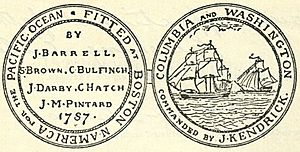
On September 30, 1787, Robert Gray and Captain John Kendrick left Boston. They planned to trade along the north Pacific coast. Captain Gray commanded Lady Washington, and Captain Kendrick commanded Columbia Rediviva. Boston merchants, including Charles Bulfinch, funded their journey.
These merchants wanted to trade animal furs from the Northwest coast. They would then take the furs directly to China. This idea came after Bulfinch read about Captain Cook's success doing the same. Cook's journals, published in 1784, talked about selling sea otter furs in Canton, China.
The ships carried blankets, knives, iron bars, and other goods for trading. Both captains had official letters from Congress and passports from Massachusetts. They sailed around Cape Horn at the tip of South America. They stopped at the Cape Verde Islands and the Falkland Islands in the Atlantic.
In January, after passing Cape Horn, a storm separated the two ships. The storm damaged Columbia Rediviva. This forced Kendrick to sail to the nearest port, Juan Fernandez, which was a Spanish port. Columbia Rediviva was repaired there before sailing to the Northwest coast.
Gray reached the Northwest coast in August 1788. He entered Tillamook Bay to get supplies. His crew were the first recorded European Americans to visit the bay. There was a fight with the local Tillamook people. Marcus Lopez, Gray's cabin boy, was killed. Gray named the bay Murderer’s Harbor.
Further north, Gray's ship got stuck trying to enter a river. The ship was attacked by Native Americans. One crew member was lost before the ship got free. On September 17, 1788, Lady Washington, with Gray in command, reached Nootka Sound.
Columbia Rediviva arrived soon after. Both ships spent the winter at Nootka Sound, near what is now Vancouver Island. They were there when Esteban José Martínez arrived in May 1789. He came to claim the area for Spain. British merchant ships also arrived, leading to the Nootka Crisis. This event almost caused a war between Spain and Britain. The American ships were not seized, but Gray saw much of the conflict.
While trading along the coasts of what are now British Columbia, Washington, Oregon, and California, the Americans explored many bays. In 1788, Gray met Captain John Meares of England. Meares later published maps that showed an imaginary inland sea. Gray told George Vancouver in 1792 that he never made such a trip.
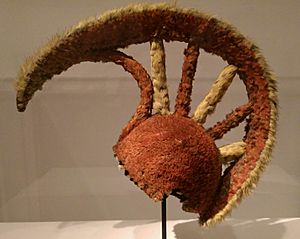
In 1788, Gray tried to enter a large river but couldn't due to the tides. He later named this waterway the Columbia River. Gray and Kendrick swapped ships during the trip. Gray took command of Columbia Rediviva. Kendrick stayed on the North American coast to trade for furs. Gray sailed their furs to China, stopping at the Sandwich Islands (Hawaii) on the way.
Gray arrived in Canton, China, in early 1790. He traded his cargo for a lot of tea. Gray then continued west, sailing through the Indian Ocean, around the Cape of Good Hope, and across the Atlantic. He reached Boston on August 9, 1790. This made Columbia Rediviva the first American ship to sail around the world.
Even though the trip didn't make much money for the investors, Gray was celebrated in Boston for his achievement. Two Hawaiian natives, Atu and Opai, traveled with Gray. They were the first Hawaiians to visit New England. Gray had Atu paraded through Boston in traditional Hawaiian war clothes. Governor John Hancock held a party to honor Gray.
This successful voyage encouraged Gray to set sail for the North Pacific coast again, just six weeks after returning. Other New England merchants also started sending their ships to join this new fur trade. By 1801, 16 American ships were involved in this trade route to China. These activities helped support American claims to the Oregon Country later on.
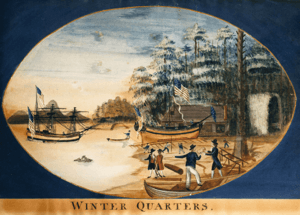
Second Trip to the Pacific Northwest (1790–1793)
Gray sailed for the Northwest coast again on the Columbia on September 28, 1790. He reached his destination in 1792. Gray and Kendrick met again for a while. On this trip, Gray sailed under official papers from the United States, signed by President George Washington.
Gray arrived at Nootka Sound on June 5, 1791. His crew built a fort there called Fort Defiance and spent the winter. During this time, they built a small 45-ton ship called Adventure. It was launched in the spring with Gray’s first mate, Robert Haswell, in charge.
In April, Gray and Columbia Rediviva sailed south. Adventure sailed north. On April 2, 1792, Gray left the trading post of Clayoquot. As he left, Gray ordered the destruction of the Nuu-chah-nulth (Nootka) village of Opitsitah (Opitsaht). This was in response to insults and rumors of a plot against his men. The village was empty at the time. John Boit, an officer on Gray's ship, wrote that Gray had gone too far. In 2005, Gray's descendants formally apologized for destroying Opitsaht.
Gray ordered several other attacks in 1792. In May 1792, he attacked a Chicklisaht Nuu-chah-nulth village, killing seven people and taking their furs. This happened after trade talks broke down. Later in 1792, in Grays Harbor, Gray fired on a group of Chinooks, killing 20. He also fought with Kwakiutl people.
During his 1792 journey, Gray saw muddy waters flowing from the shore. He decided to investigate if it was the "Great River of the West." On April 29, Gray met a British ship, HMS Discovery, commanded by Captain George Vancouver. They talked about the coast. Gray told Vancouver about the large river he tried to enter in 1788. Vancouver doubted a big river was there. So Gray continued south, leaving the Strait of Juan de Fuca on April 30, 1792. He traded for more furs as he sailed. On May 7, he took Columbia Rediviva into the bay of Grays Harbor, Washington. Gray actually named this Bullfinch Harbor, but Vancouver's name stuck.
Finding the Columbia River
Gray continued south to what he believed was the mouth of a great river. On May 11, his men found a way into the river. They launched a small sailboat to find a safe path across the sandbars. Finally, on the evening of May 11, 1792, Gray's men found a safe channel. The ship and crew sailed into the Columbia River estuary.
Once inside, they sailed upriver. Gray named this large river Columbia after his ship. Many Native Americans in their canoes met them. The crew took on fresh water. The ship traveled about 13 miles (21 km) upriver. They traded items like nails for furs, salmon, and meat for nine days.
Gray also named other places like Adams Point and Cape Hancock. However, many of these places have been renamed. The farthest point Gray explored upriver is now called Grays Bay. The river flowing into it is Grays River. These names were given by William Robert Broughton, Vancouver's lieutenant, who explored the Columbia in October 1792. Gray had made a map of the bay and river mouth.
Gray's success in entering the river later helped the United States claim the Oregon Country. On May 20, Gray and his crew sailed from the Columbia. They headed north to meet their small ship Adventure before sailing to China.
At Nootka Sound
On July 22, 1792, Gray sailed Columbia Rediviva into Nootka Sound. The ship Hope was also there. Juan Francisco de la Bodega y Quadra was the Spanish commander. Bodega was waiting for George Vancouver to discuss the Nootka Convention.
Bodega asked the Americans for their side of the story about the Nootka Crisis of 1789. Ingraham and Gray wrote a long letter. They said that the British captain John Meares had made many false claims. They stated that Meares' "house" at Nootka Sound was just a "rough hut" built and torn down in 1788. They also said Meares had not bought any land from Maquinna.
Bodega was happy to get the Americans' account. When Vancouver arrived, Bodega used this report to make negotiations difficult. The Americans were not neutral. They had just gained independence from Britain. They also competed with the British for the fur trade. It was in their interest to support the Spanish.
Bodega provided Gray with a small house and repaired Columbia Rediviva. He also gave them fresh food every day. When Gray and Ingraham left, they received large amounts of food. Bodega refused any payment.
In September, most ships left Nootka Sound, including Columbia Rediviva. Bodega also left. Bodega bought the Adventure from Gray at Neah Bay. Gray then took the Columbia to Port San Juan to prepare for the long trip across the Pacific. Gray left North America on October 3, 1792. He arrived in the Hawaiian Islands on October 29 and in Macau on December 8.
Return to Boston
In Canton, China, Gray again traded his cargo for tea. He then sailed west back to the United States. Gray returned to Boston in July 1793, completing another trip around the world. On February 3, 1794, he married Martha Atkins in Boston. They had five children together.
Later Life and Death
Later in his career, Gray was involved in the Quasi-War (1798–1800). This was an undeclared naval conflict between the United States and France.
On September 10, 1798, Gray sailed from Salem on the ship Alert. He planned another fur trading trip to the Northwest Coast, then to Canton, and home. However, a French privateer captured his ship in the South Atlantic on November 17. Alert was taken to the Spanish port of Montevideo and sold. Gray returned to the United States and continued his sailing career.
In 1799, Gray commanded the privateer ship Lucy. It had 12 guns and a crew of 25.
On November 21, 1800, Gray left Boston commanding the schooner James. He sailed to Rio de Janeiro. He also made later trips to England and the southern United States. Gray died at sea in 1806, near Charleston, South Carolina. It is believed he died from yellow fever. He left behind his wife and four daughters. His wife later asked the U.S. Congress for a government pension.
Legacy
Gray did not publish his discoveries on the Columbia River or other parts of the Pacific coast. Captain Vancouver published Gray's discoveries in England and gave him credit. At the time, Gray's discoveries were not seen as very important.
However, the trading opportunities Gray opened up for Americans were soon followed by other merchants. As a result, the Native Americans of the Northwest Coast began to call Americans "Boston men." Also, Gray's discovery of the Columbia River was later used by the United States to support its claims to the Oregon Country. The British called the southern part of this area the Columbia District, named after the river Gray found. This name later became British Columbia when it joined Canada.
Places Named After Robert Gray
- Grays Harbor and Grays Harbor County, in Washington
- Grays Bay, on the north shore of the Columbia River estuary
- Grays Point, at the west of Grays Bay
- Grays River, a river that flows into Grays Bay
- Grays River, Washington, a small village on the river
- The Robert Gray Neighborhood in Tiverton, Rhode Island
- Robert Gray Avenue in Tiverton, Rhode Island
- Robert Gray Middle School in Portland, Oregon
- Robert Gray Middle School in Tacoma, Washington
- Captain Robert Gray Elementary in Astoria, Oregon
- Robert Gray Elementary School in Aberdeen, Washington
- Robert Gray Elementary School in Longview, Washington
- Robert Gray Baptist Church in Longview, Washington
- Captain Gray Elementary School in Pasco, Washington
- Grayland, WA, a small area on the Washington Coast
See also
 In Spanish: Robert Gray para niños
In Spanish: Robert Gray para niños



